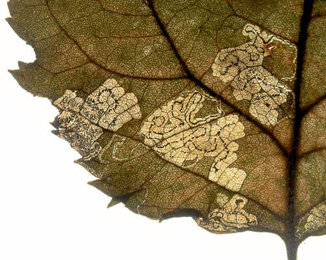|
||||||
|
Stigmella
desperatella (Frey, 1856) Scarce Apple Pigmy Nepticula
desperatella
Frey, 1856. Tin. Pteroph. Schweiz.:
374. |
|||||||||||||||||||||||||||||||||||||||||||||||||
Leaf-miner: Egg either at upperside or underside of the leaf. The mine begins as a narrow cooridor, often following a vein or the leaf margin. Later sections of the corridor are mch wider and contorted, mostly forming a secondary blotch. Frass in a narrow central line, sometimes a bit broader towards then end of the mine. Often several mines a a leaf (Bladmineerders van Europa). Initially the long slender gallery, with a thin central frass line, may follow the leaf edge. It then widens suddenly and twists to form a blotch-like mine. The frass is still in a thin central line with clear margins to the gallery. The mine may be confused with S.malella but with this species the larva is yellow whereas with desperatella it is green. There may be several mines in a leaf. Vacated mines cannot be identiufied with certainty (British leafminers).
Larva: The larvae of moths have a head capsule and chewing mouthparts with opposable mandibles (see video of a gracillarid larva feeding), six thoracic legs and abdominal legs (see examples).The larva is green; this distinguishes the species from malella, that also lives on apple, but has a green larva. Also magadelenae may be found on apple, and this species has green larvae. The only reliable difference is that the larva of magadelenae has a field of fine spinules on abdomen 9, that is lacking in desperatella (Emmet, 1983a; Gustafsson and van Nieukerken, 1990a) (Bladmineerders van Europa). Pupa: The pupae of moths have visible head appendages, wings and legs which lie in sheaths (see examples). Adult: The adult is not illustrated in UKMoths (check for update). The species is included in mothdissection.co.uk. Hosts in Great Britain and Ireland:
Hosts elsewhere:
Time of year - larvae: Currently unknown. Time of year - adults: Currently unknown. Distribution in Great Britain and Ireland: Britain incluidng West Norfolk (NBN Atlas). See also British leafminers distribution map. Distribution elsewhere: Widespread in continental Europe including Austria, Bosnia and Herzegovina, Bulgaria, Croatia, Czech Republic, Estonia, French mainland, Germany, Hungary, Italian mainland, Lithuania, Republic of Moldova, Poland, Romania, Slovakia, Slovenia, Switzerland and Ukraine (Fauna Europaea). NBN Atlas links to known host species:
British and Irish Parasitoids in Britain and elsewhere:
|
|||||||||||||||||||||||||||||||||||||||||||||||||
|
|
|
| External links: | Search the internet: |
|
Belgian Lepidoptera Biodiversity Heritage Library Bladmineerders van Europa British leafminers Encyclopedia of Life Fauna Europaea NBN Atlas NHM UK Checklist UKMoths |
Find
using Google Find using Google Scholar Find images using Google |
| Last updated 12-Jul-2019 Brian Pitkin | ||

